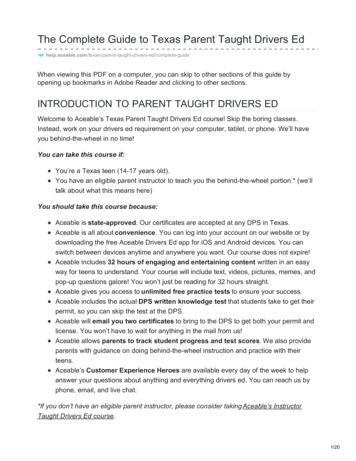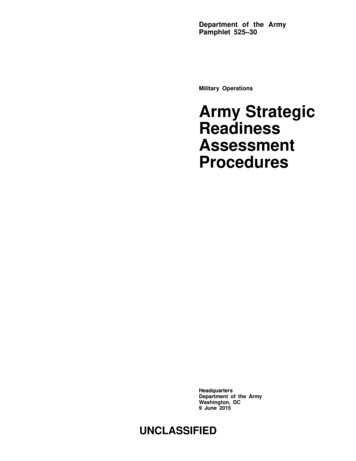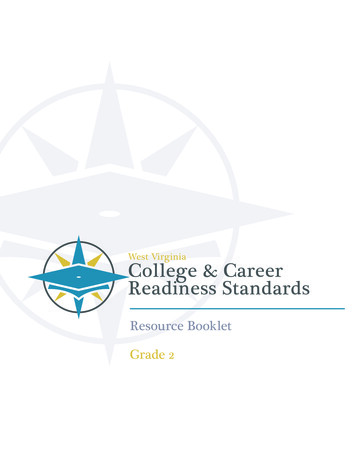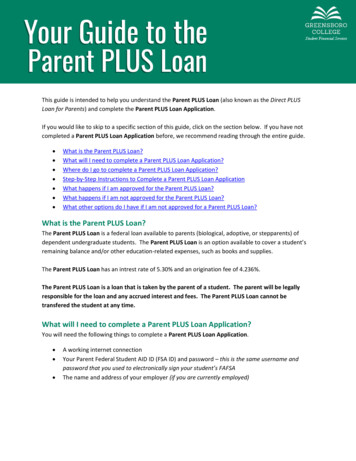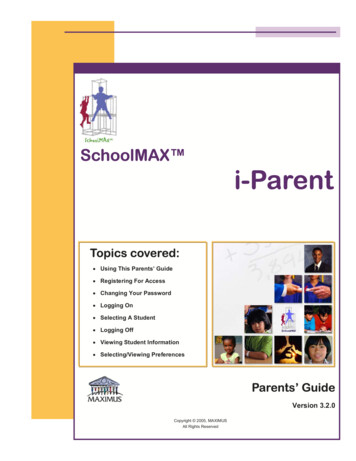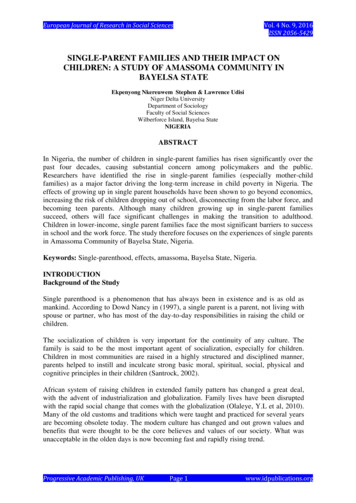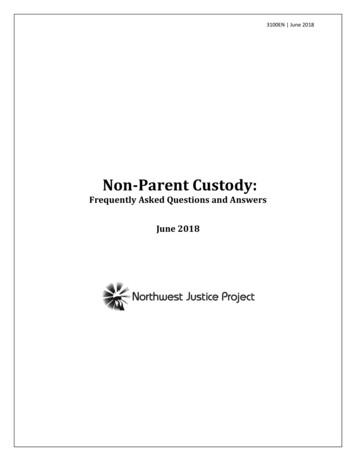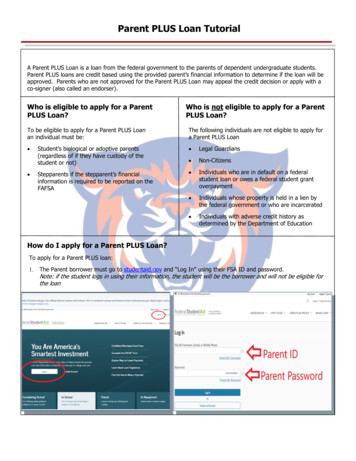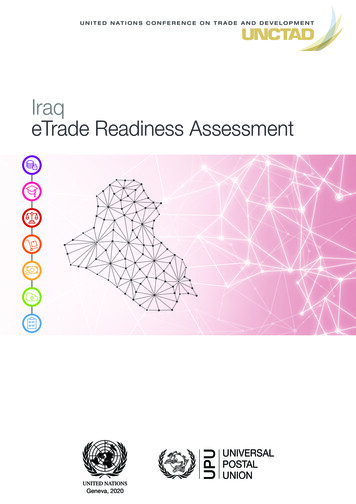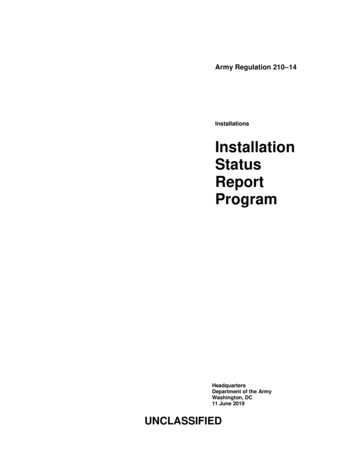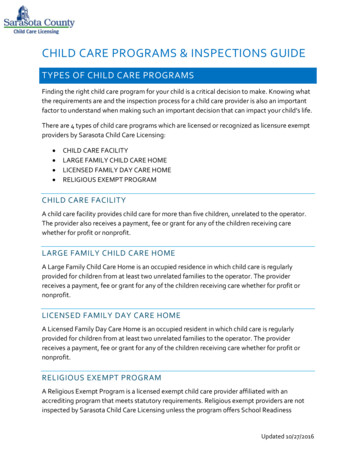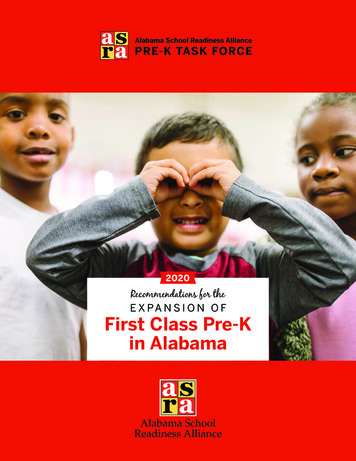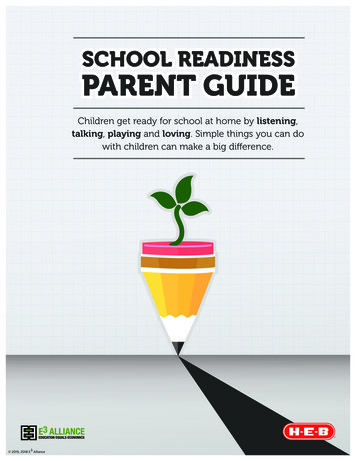
Transcription
SCHOOL READINESSPARENT GUIDEChildren get ready for school at home by listening,talking, playing and loving. Simple things you can dowith children can make a big difference.3 2015, 2018 E Alliance
Dear parents and caregivers,This guide was created for you! It provides easy-to-use tools to helpyour children successfully prepare to enter school. There is even achecklist for each activity. You can work on the same skills pre-K andKindergarten teachers use to measure if children are ready for school.We would love to hear from you on how you are using this guide andways we might be able to continue to improve it to meet your needs.Here is to every child’s success in school!LAURA KOENIGDIRECTOR, SCHOOL READINESS TEAMlkoenig@e3alliance.orgELGIN ISD Download a copy of this guide www.e3alliance.org
1BUILDING LANGUAGE SKILLSSCHOOL READINESS PARENT GUIDE: PREPARING CHILDREN FOR SCHOOL SUCCESSIMPORTANCE: Talking, singing and telling stories helps children learn about the world aroundthem. Listening to children helps them express their thoughts and ideas. When children understandlanguage and are able to express themselves, they learn more in school.ACTIVITIES:1.STORY TELLING:Tell children stories about when you were a child.Stories can be simple – Your favorite holiday Your favorite food A time when you were happy or sadDESCRIBE WHAT YOU ARE DOING AS YOU ARE DOING IT:2.Saying what you are doing, while you are doing it builds yourchild's vocabulary. Talking about cleaning the house, or makingdinner, or driving down the road, but your words build yourchild’s vocabulary. The more words they know, the more toolsthey have for language and learning! Think about how manywords you could use when folding laundry: SoftSparklyMetalDark WhiteSockTowelPurple OrangeBlueWarmDampWhen children touch, see or feel something they make a memoryfor that word. When the child has a memory of a word, they will beable to understand and use the word.SCHOOL READINESS PARENT GUIDE13 2015, 2018 E Alliance
1 Ask your child to retell a story to you.2 Ask your child about their favorites things and listen.?3 Ask your child to point out signs with their favorite letters,numbers or colors.ASKQUESTIONS:4 Ask your child what they want to do and why.5 Ask your child what three things made them happy today.6 Ask your child what three things that made them sad today.CHECK LIST As you try these activities, reflect on the skills your child is building that helpthem get ready for school. These skills can help children start school strong!Child is able to express needs, for example “I want juice.”Child is able to tell other people what to do, for example “Go away.”Child uses language to make contact with others, for example “Let’s Play.”Child uses language to express their opinions or feelings, for example“I like ice cream.”Child uses language to find out more about something, for example“How do airplanes fly?”Child uses language to create, for example “I will be a monster andyou can be a dragon.”Child uses language to convey facts, for example “The rain helps the plants grow.”Child is able to retell or re-enact a story after they hear it.Child is able to speak in complete sentences, for example saying “I need help.”instead of just “help.”Child uses a variety of words.free tips by text for parents andcaregivers of children under 5text*Message and data rates may apply. Text STOP to 274448 to STOP.SCHOOL READINESS PARENT GUIDEto 274448with your childevery day!www.e3alliance.org2www.e3alliance.org3 2015, 2018 E Alliance
2LEARNING SOUNDSSCHOOL READINESS PARENT GUIDE: PREPARING CHILDREN FOR SCHOOL SUCCESSIMPORTANCE: Talking, singing and telling stories helps children learn about the world aroundthem. Listening to children helps them express their thoughts and ideas. When children understandlanguage and are able to express themselves, they learn more in school.ACTIVITIES:1.SING SONGS:Simple Children’s Songs teach children rhythm and rhyme, and children can learnthe same thing from hearing you sing your favorite song.Here are some simple songs you can try: Row, Row, Row your boat, gently down the steam. Merrily, merrily, merrily, merrilylife is but a dream. The itsy-bitsy spider went up the water spout. Down came the rain and washedthe spider out! Out came the sun and dried up all the rain, and the itsy-bitsy spiderwent up the spout again. You are my sunshine, my only sunshine. You make me happy when skies are gray.You’ll never know dear, how much I love you. Please don’t take my sunshine away.There are also great songs about colors that are available on youtube.com.For more resources on music with children visit www.pbs.org.SCHOOL READINESS PARENT GUIDE33 2015, 2018 E Alliance
2.RHYME TIME:Reading simple rhyming stories like “Green Eggs and Ham” or a book ofNursery Rhymes helps children hear the sounds in the words. When you readwith your child, you can stop and ask them to finish the rhyme. You can dothis with books, nursery rhymes or songs. You can even make up your own rhymes.Here is an example of a children’s rhyme that you may be familiar with:Adult:Child:Jack and JillWent up thehill!CHECK LIST As you try these activities, reflect on the skills your child is building that help themget ready for school. These skills can help children start school strong!Child is able to complete rhymes most of the timeChild is able to sing familiar songsChild is able to clap along with songsChild is able to do finger movements to familiar songsfree tips by text for parents andcaregivers of children under 5text*Message and data rates may apply. Text STOP to 274448 to STOP.SCHOOL READINESS PARENT GUIDEto 274448with your childevery day!www.e3alliance.org4www.e3alliance.org3 2015, 2018 E Alliance
3TRIP TO THE STORESCHOOL READINESS PARENT GUIDE: PREPARING CHILDREN FOR SCHOOL SUCCESSIMPORTANCE: Children learn from every day experiences. Anytime is learning time for youngchildren. At the store, children can learn to follow rules, make plans and learn new words. Theseactivities can be done when you are out and about with your children. Going to the park, ridingthe bus and going to the library are great for learning new rules and new words.ACTIVITIES:Important tips: Shopping can wear you out! Before you go, make sure that both you and your childeat a healthy snack. When children are hungry, they are more likely to be irritable or grab for items inthe store (and you are too!). Healthy low-sugar snacks can help both children and adults focus andbe on their best behavior.SNACK SUGGESTIONS: Raisins fresh fruit crackers nuts carrots yogurt cheeseTALK ABOUT THE ITEMS YOU SEE AT THE STORE:1.This a wonderful way to learn new words. The produce departmentis a great place to talk about how different things look, feel and smell.First, start by describing what you see, then ask children questionsabout what they see. Here are some phrases you may want to try: “The avocados are really soft today, want to feel? They arebumpy, but this spot – it is too soft.” “Oh, look those apples are so red, but those other apples are green.” “What color is it?” “Tell me about the apple? What do you see, smell, feel?” “How many words can you use to describe the banana? Let’s count.” “I love the way oranges smell, so fresh.”MAKE A GROCERY LIST:2.Make a grocery list for you and help your child make one, too.Having a list helps children become engaged and stay interested.SCHOOL READINESS PARENT GUIDE53 2015, 2018 E Alliance
A.Help your child make his own list with just 3-4 items on it. This helps him practicehis writing or holding a pencil even if just scribbling or drawing a picture of items ontheir list. If your child wants to write down words, help him by writing out a wordfor him to copy onto his list. Your child can practice letter by letter. Also, help yourchild write his name at the top of the list.John Milk Bread ApplesB. Have your child count the number of items left on the list and cross items offwhen they go in the cart.C. Have your child find items that start with letters. “Find the ‘M’ for ‘Milk’”. “Ok cross thatoff; we have it!” Checking items off the list helps him know how much moreshopping is left to do.CHECK LIST As you try these activities, reflect on the skills your child is building that help himget ready for school. These skills can help children start school strong!Child can make marks that look like lettersChild can write her first nameChild can identify at least 20 upper and 20 lower case lettersChild can tell you what comes next in a series, a plan or a storyChild can use words to describe things in the storeChild is able to stay on task for several minutes(making the list or looking for items in the store)Child is able to describe objects with a variety of words, for example“It is yellow, prickly and smells sweet.”free tips by text for parents andcaregivers of children under 5text*Message and data rates may apply. Text STOP to 274448 to STOP.SCHOOL READINESS PARENT GUIDEto 274448with your childevery day!www.e3alliance.org6www.e3alliance.org3 2015, 2018 E Alliance
4WHY RULES?SCHOOL READINESS PARENT GUIDE: PREPARING CHILDREN FOR SCHOOL SUCCESSIMPORTANCE: Rules help keep children safe. Rules also give children guidance on what peopleexpect of them. To follow rules, children need to understand and remember them. When childrenhelp create the rules, it helps them think about what they need to do. It helps children rememberwhat the rules are, and why the rules are needed. It also gives children a chance to ask questions.REMEMBER, following rules is a habit that takes practice.ACTIVITIES:1.TALK WITH YOUR CHILD ABOUT THE RULES FOR ACTIVITIES:A. What rules do you need for the store to be safe? Do your children need to staynext to you or hold your hand? Have your children help make the rules beforeyou go to the store, park or library. Telling children the reasons for the ruleshelps them understand why they need to follow them.B. Here are some phrases you may want to say to your child: “We need to be safe in the grocery store. There are a lot of people, and Idon’t want to lose sight of you because you could get lost. What other thingsdo we need to remember to be safe?” “We need to buy food that helps us grow. Candy does not help our bodiesgrow. What foods are good for us?” Staying positive is important. Children learn best when they are calm. If childrenbreak rules, get close to them at eye level, speak calmly and briefly to them.“Our rule is that you hold my hand, so you can be safe. Please hold my hand.” What are some other phrases you could say?:SCHOOL READINESS PARENT GUIDE73 2015, 2018 E Alliance
MAKE A PLAN:2.Talk to your child about what the plan is for an activity: what you want to do first, next andlast. Children are less anxious when they know what is going to happen. This also helps childrenunderstand order of things. It can help develop strategic thinking, as well as patience.CHECK LIST As you try these activities, reflect on the skills your child is building that help herget ready for school. These skills can help children start school strong!Child helps develop rulesChild can follow the rules most of the time with just a few remindersChild can tell you what comes next in a series, a plan or a storyChild is able to stay on task for several minutes(making the rules or listening to the plan)free tips by text for parents andcaregivers of children under 5text*Message and data rates may apply. Text STOP to 274448 to STOP.SCHOOL READINESS PARENT GUIDEto 274448with your childevery day!www.e3alliance.org8www.e3alliance.org3 2015, 2018 E Alliance
5READ! READ! READ!SCHOOL READINESS PARENT GUIDE: PREPARING CHILDREN FOR SCHOOL SUCCESSIMPORTANCE: Reading to children helps them be ready to become readers. Reading to childrenlets them know that letters represent words and words stand for ideas. Children also learn how tohold a book, how to turn pages and that pictures help tell the story. All of these skills put togetherhelp children get ready to read! Peaceful time spent close to children, helps them relax, feel good,and calmly process what they are learning. When you spend time with your children reading, it letsthem know reading is a good and important thing to do. Reading at home, in the car or in thedoctor's office is a valuable way to spend time with children.ACTIVITIES:READ, READ, AND RE-READ:Children love reading books over and over again. Reading the same stories over and over helpschildren understand more and more about the words in the story. Children will look at thepictures and the words on the page and start making connections. They start to understand that“Once” starts with the letter “O”. Stories have a beginning, a middle and an end. The more storieschildren hear, the more they recognize this pattern. Ask your child questions about the wordsin the book and the story. Talk about a story before, during and after you read with them. Thishelps children think more about what they are hearing and seeing. “Can you find a word that starts with the letter ‘C’?” “How do you think he feels?” “Did you like that story? Why?” “What do you think happens in the story?” “What do you think will happen next?” “What could have happened instead?” “Who was your favorite character in the story?”NEED HELP FINDING A BOOK:Help in choosing books for children at PBS.orgFree books are available at local librariesComprehensive site of free eBooksSCHOOL READINESS PARENT GUIDE93 2015, 2018 E Alliance
CHECK LIST As you try these activities, reflect on the skills your child is building that help himget ready for school. These skills can help children start school strong!Child holds a book right side upChild turns pages in a book, with a purpose to look at pictures or to be read toChild is able to re-tell a story after it is read out loudChild can identify characters in a bookChild can describe the beginning, middle and end of a storyChild understands and can identify feelings of a character in a storyChild can pay attention to a short children’s book being read out loudfree tips by text for parents andcaregivers of children under 5text*Message and data rates may apply. Text STOP to 274448 to STOP.SCHOOL READINESS PARENT GUIDEto 274448with your childevery day!www.e3alliance.org10www.e3alliance.org3 2015, 2018 E Alliance
6UNDERSTANDING EMOTIONSSCHOOL READINESS PARENT GUIDE: PREPARING CHILDREN FOR SCHOOL SUCCESSIMPORTANCE: Children have big emotions. They are impulsive. Often children act out their feelings,and can hurt others. Talking with children about big feelings can help them think before they act. Whena child can tell an adult what is bothering them, they feel less frustrated, and can get help. A child thatsays “I am angry!” instead of pushing someone away, gets in less trouble. Adults can show childrenhow to calm down and be respectful and kind to others. Adults can also help children identify andunderstand their feelings.ACTIVITIES:TALK ABOUT YOUR FEELINGS:A. It is very important to talk through what the child is feeling with her,and to discuss and model for her what is the appropriate way to manageyour feelings with others. Talk about how you are feeling every day, andask your child how she is feeling. It is o.k. to experience negative andpositive emotions and share them with your child. This can be done anytime. Here are some phrases that you may want to practice with your child: “I am frustrated that we are running late.” “I am so happy that you remembered to wash your hands.”ANGRY “It has been a long day; I am tired.” “I am really looking forward to spending time with you.”B. How is your child feeling? Are they happy, sad, frustrated, angry, bored,ANGRYtired, or hungry? Talk with your child about their feelings. Lookand theirFRUSTRATEDSADface and tell them what you see. This helps children identify the wordsthat match their feelings. When children can identify their feelings it helpsthem use words instead of actions to express themselves. It also helps ANGRYthem recognize how other people are feeling.SADJOYFUL “You have a frowny face on and your eyebrows are all crinkly.TIREDYou look frustrated. “ “You have a big smile on your face and look very proud thatyou made that basket.”SAD “I can tell you are embarrassed because you have your headTIREDEMBARRASSEDdown and you are looking worried.” “You just knocked over the blocks and threw them acrossthe room. You look very angry.”SCHOOL READINESS PARENT ED3 2015, 2018 E AlliancePROUD
SEDPROUDCHECK LIST As you try these activities, reflect on the skills your child is building that help herget ready for school. These skills can help children start school strong!Child can identify and label her own feelings.Child can identify and label other people’s feelings.Child will comfort someone who is hurt or sad.Child rarely hurts, threatens or yells at children or adults.free tips by text for parents andcaregivers of children under 5text*Message and data rates may apply. Text STOP to 274448 to STOP.SCHOOL READINESS PARENT GUIDEto 274448with your childevery day!www.e3alliance.org12www.e3alliance.org3 2015, 2018 E Alliance
7PLAYING WELL WITH OTHERSSCHOOL READINESS PARENT GUIDE: PREPARING CHILDREN FOR SCHOOL SUCCESSIMPORTANCE: A big part of school is being in the classroom with other children and getting along.There are some things that families can do to help prepare children for playing and learning withfriends. Children also learn a lot from each other. Opportunities for playing with other children canbe great experiences for them.ACTIVITIES:1.PLAYING WITH OTHER CHILDREN:Children can play with other children at parks, pools and places of fellowship.These interactions can help your child build important skills for school. If childrenare not getting along, encourage them to work things out together by askingthem simple questions: “It sounds like you both want to be the leader, how are yougoing to work that out?” “What do you each think would be fair?” “How can you play together without hurting each other?”2.WHAT TO DO WITH BIG FEELINGS:Make plans with your child about what you can do with BIG feelings: excited,happy, angry, sad. When children have a big emotion they can become veryphysical. It can help them to have a plan a head of time to express their emotions.Strategies for big emotions: Take a deep breath and blow it out slowly, like you are blowingout a birthday candle. Repeat until you feel calmer. Rub your hands together back and forth. Squeeze a pillow or soft object. Jump up and down in place. If it is safe to, run around for 10 seconds. Count to three slowly, then talk about what you are feeling. Talk with your child about what helps her feel calmer,and help her use this strategy regularly.SCHOOL READINESS PARENT GUIDE133 2015, 2018 E Alliance
CHECK LIST As you try these activities, reflect on the skills your child is building that help himget ready for school. These skills can help children start school strong!Child will share space with other children.Child will share toys or food with other children.Child participates in problem-solving to resolve conflicts.Child will follow the lead of another child.Child will take on a leadership role in a group.Child rarely hurts, threatens or yells at children or adults.free tips by text for parents andcaregivers of children under 5text*Message and data rates may apply. Text STOP to 274448 to STOP.SCHOOL READINESS PARENT GUIDEto 274448with your childevery day!www.e3alliance.org14www.e3alliance.org3 2015, 2018 E Alliance
8ROUTINES HELPSCHOOL READINESS PARENT GUIDE: PREPARING CHILDREN FOR SCHOOL SUCCESSIMPORTANCE: A regular routine can help children move from one activity to another more easily.In school children will have a very regular schedule. At home, having a regular routine can helpchildren feel safe. Children are more comfortable when they know what will happen next. Childrenwho are able to follow a schedule and routine, will be better prepared for school.ACTIVITIES:1.ROUTINES DO NOT HAVE TO BE EXACT or a down to the minute schedule;just a predictable sequence of events. For instance, a simple morning routine could be: First we wake up We make our bed Next we use the potty and wash hands We get dressed Then, we eat breakfastLetting your child know the routine and then sticking to it helps her understand and planfor the day and lets her know what you expect. Does she need to make her bed? Or washher hands? Clean up toys? If she knows it is part of a regular routine, she gets used to herresponsibilities. Of course, not every day is the same, and the unexpected will happen.Letting your children know that there may be a change of plans is always a good idea.NAP-TIME AND BED-TIME ROUTINES:2.Make sure that your child gets the sleep he needs. Typically children between 3 and6 years old need at least 10-12 hours of sleep every day. For children who have to be at schoolat 7:30 a.m., that means a bed time of 7:00 p.m. – 9:00 p.m. As any parent knows, bed-timecan be a difficult transition time for children. A routine helps them make that transition moreeasily. A typical bedtime routine could be: Dinner Short activity (building blocks, playing games, singing songs) Preparing for the next day (clean up, putting away dishes,laying out clothes, etc) Bath Reading books in bedZ Lights outZSCHOOL READINESS PARENT GUIDE15ZZ3 2015, 2018 E Alliance
MORE HELPFUL ROUTINES IDEAS:3. Ask your child to help you create a daily routine Post the daily routine on the fridge at your child's eye level Have a symbol (sun for morning, moon for night, flowers, animals) for each routine Take a photo of your child doing each activity and put it next to the routine on the chart Empower your child by asking him “What is next on your chart?” Praise the effort, not the child. Instead of saying “good girl” or “good boy” focus onhis work, e.g. “ You brushed your teeth tonight, right after your bath. You must be proudyou remembered that.”CHECK LIST As you try these activities, reflect on the skills your child is building that help herget ready for school. These skills can help children start school strong!Child can move easily through different activities.Child is able to tell what activity comes next in a sequence of events.Child is able to complete activities in her regular routine (cleaning upa room or brushing teeth), with just a few reminders.Child is able to complete all the steps to use the toilet and washhands without assistance.Child is able to complete two-step directions regularly, for example“Put on your shoes and brush your hair.”Child is able to complete three-step directions often, for example“Pick up the trash on the floor, put away the toys and go to the bathroom.”free tips by text for parents andcaregivers of children under 5text*Message and data rates may apply. Text STOP to 274448 to STOP.SCHOOL READINESS PARENT GUIDEto 274448with your childevery day!www.e3alliance.org16www.e3alliance.org3 2015, 2018 E Alliance
9CHILD’S PLAYSCHOOL READINESS PARENT GUIDE: PREPARING CHILDREN FOR SCHOOL SUCCESSIMPORTANCE: When children play games, they learn a lot! Children learn to follow rules. They payattention. They use self control. Playing games can help a child improve memory and increase andproblem solving ability. Being physically active also helps children build balance and coordination.Plus, it is fun!ACTIVITIES:There are many SIMPLE GAMES that you can play with children:1.I SPY Play with at least two players. Players try to guess what another player sees based on clues, questions and answers. Player 1 looks for something they can see. This can be a car, a bike, a building, a book, a toy,a shirt – anything. Player 1 begins the game with saying, “I spy with my little eye something.” They add a clue about the object such as the color of the object, the shapeof the object or what you can do with the object. The other players ask questions about the object (taking turns if there is more than twopeople playing). “Is it big?” “Is it green?” Player 1 can only answer “yes” or “no”. Once a player thinks she knows the answer, she can guess if it is the object. “Is it that book?”If she guesses correctly, she gets to find something and give the next clue, “I spy with mylittle eye something .” If she is incorrect, play continues until a playerguesses correctly.RED LIGHT/ GREEN LIGHT:2. Play with at least two players. One person is the “stop light” and the other players try to touch him. At the start, children form a line about 10 feet away from the “stop light”. The ”stop light” faces away from the line of children and says, “green light”.At this point the kids are allowed to move towards the “stop light”. The ”stop light” says, “red light!” and then turns around. If any of thechildren are caught moving during a red light, they are out. The “stop light” turns back around and says, “green light”. The first child to touch the ”stop light” wins. The stop light wins if all the children are out before anyoneis able to touch him.SCHOOL READINESS PARENT GUIDE173 2015, 2018 E Alliance
3.SIMON SAYS: Play with at least two players. One person is the leader, “Simon”. “Simon” orders the other players to do things (usually very silly things). Players only obey the command when Simon uses the phrase“Simon says .” For instance if the leader says“Simon says, touch your head,” all the other players must touchtheir heads. If the leader says, “Touch your feet” but does not say, “Simon says,touch your feet,” any player who touches his feet would be out. The leader keeps giving commands until there is one person left. That person wins the game and becomes the new leader.Simon Says,touch your Head!CHECK LIST As you try these activities, reflect on the skills your child is building that help themget ready for school. These skills can help children start school strong!Child takes turn in a gameChild can wait her turnChild can follow directionsChild understands the rules of the gameChild can tell you the rules of the gameChild is kind to other players in a gameChild does not get overly upset if she loses the gameChild can resolve conflicts that come up during playChild can stand on one foot and hopChild uses a variety of wordsfree tips by text for parents andcaregivers of children under 5text*Message and data rates may apply. Text STOP to 274448 to STOP.SCHOOL READINESS PARENT GUIDEto 274448with your childevery day!www.e3alliance.org18www.e3alliance.org3 2015, 2018 E Alliance
10A,B,C’SSCHOOL READINESS PARENT GUIDE: PREPARING CHILDREN FOR SCHOOL SUCCESSIMPORTANCE: Letters are the building blocks to words. Knowing your A, B, C’s is much more thansinging a song. Children who can recognize their letters and identify the sounds that letters make aregetting ready to become readers!ACTIVITIES:Sing the Alphabet song over and over and over with your children.Show children upper and lower case letters (in books, magazines,newspapers, on signs or billboard, on products in the grocery store).Encourage your child to draw a picture and tell you a story about it.Write the story down next to the picture.Write your child’s name for her and encourage her to practicewriting her own name.Teach letters through names- your child’s and those of siblings,parents, and other people who are important to your child.Encourage your child to use any letter sounds she knows to tryto write (“Bdy” for “Birthday”)ACompare letters that look similar (M and N) and sound familiar (V and F.)Play a game where you take turns thinking of words that start withan “A” sound like “Ant” or “Apple, a “B” sound like “Bread” or “Banana”,and so on.Read books with your child and point to the words you are reading.Ask children to identify letters they see in books.Label everyday objects around the house. Take a piece of paperand make labels for things like “table”, “chair”, “couch”, “TV”, “sink”.For more ideas on learning letters visit PBS.org.SCHOOL READINESS PARENT GUIDE193 2015, 2018 E Alliance
Aa Bb Cc Dd Ee Ff Gg Hh Ii Jj Kk Ll Mm Nn Oo Pp Qq Rr Ss Tt Uu Vv Ww Xx Yy Zz CHECK LIST As you try these activities, reflect on the skills your child is building that help themget ready for school. These skills can help children start school strong!Child is able to identify at least 20 Upper Case lettersChild is able to identify at least 20 lower case lettersChild is able to identify all the letters in his or her nameChild is able to write his or her own namefree tips by text for parents andcaregivers of children under 5text*Message and data rates may apply. Text STOP to 274448 to STOP.SCHOOL READINESS PARENT GUIDEto 274448with your childevery day!www.e3alliance.org20www.e3alliance.org3 2015, 2018 E Alliance
11SORTINGSCHOOL READINESS PARENT GUIDE: PREPARING CHILDREN FOR SCHOOL SUCCESSIMPORTANCE: Children that can classify items are able to understand how things are a like, ordifferent. It helps them make connections. This helps them better understand our world. Whenchildren can describe what they see and what they know, they do better in school. It also helpsthem become problem solvers.ACTIVITIES:1.SORT LAUNDRY:Ask your child to help sort laundry. “Can you find all the socks?” “Can you find all the shirts?” “What makes them alike?” “What makes them different?” “How many do we have?”GATHER ITEMS FROM AROUND THE HOUSE(buttons, cans, boxes, forks, spoons, rocks, acorns, etc.):Ask your child to describe and sort the objects. “Can you put all the red objects together?” “Can you put the objects that are alike toge
The itsy-bitsy spider went up the water spout. Down came the rain and washed the spider out! Out came the sun and dried up all the rain, and the itsy-bitsy spider went up the spout again. You are my sunshine, my only sunshine. You make me happy when skies are gray. You'll never know dear, how much I love you.
